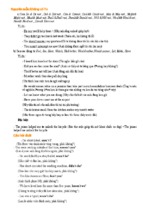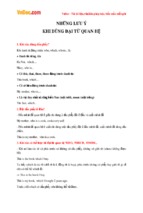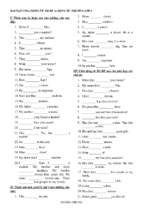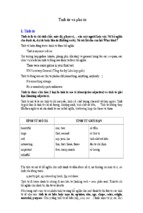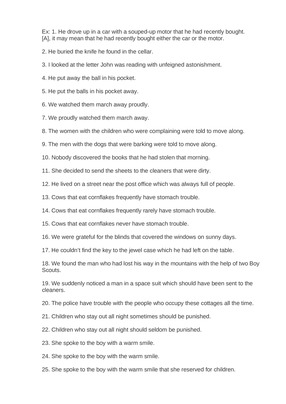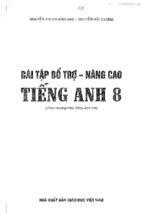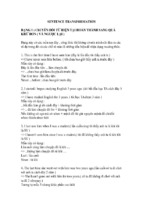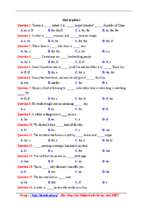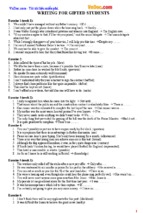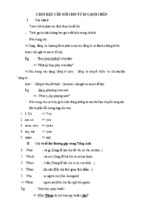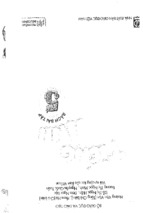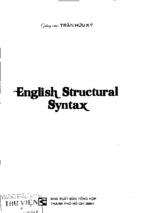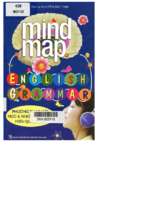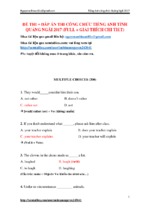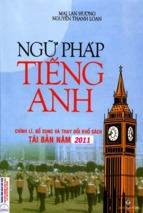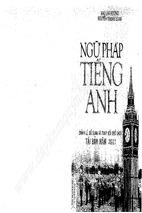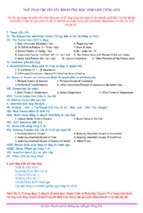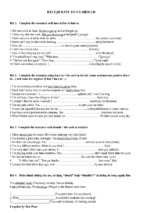PRACTICE TEST 1
Section 3
Câu 01 – 10:
The Stone Age was a period of history which began in approximately 2 million
B.C. and lasted until 3000 B.C. Its name was derived from the stone tools and
weapons that modern scientists found. This period was divided into the Paleolithic,
Mesolithic, and Neolithic Ages. During the firth period (2 million to 8000 B.C.),
the firth hatchet and use of fire for heating and cooking were developed. As s result
of the ice Age, people were forced to seek shelter in caves, wear clothing, and
develop new tools.
During the Mesolithic Age (8000 to 6000 B.C.), people made crude pottery and the
first fish hooks, took dogs hunting, and developed the bow and arrow, which were
used until the fourteen century A.D.
The Neolithic Age (6000 to 3000 B.C.) saw humankind domesticating sheep,
goats, pigs and cattle, being less nomadic than in previous ears, establishing
permanent settlements, and creating governments.
Questions:
1. Into how many periods was the Stone age divided?
A) 2
B) 3
C) 4
D) 5
2. The word “derived” is closest in meaning to
A) Originated
B) Destroyed
C) Hallucinated
D) Discussed
3. Which of the following developed earliest?
A) Fish hook
B) Hatchet
C) Bow and arrows
D) Pottery
4. Which of the following developments is NOT related to the conditions of the Ice
Age?
A) Farming
B) Clothing
C) Living indoors
5. The word “crude” is closest in meaning to
D) Using fire
A) Extravagant
B) Complex
C) Vulgar
D) Primitive
6. The author states that the Stone Age was so named because
A) It was very durable like stone
B) The tools and weapons were made of stone
C) There was little vegetation
D) The people lived in stone caves
7. “Nomadic” is closest in meaning to
A) Sedentary
B) Wandering
C) Primitive
D) Inquisitive
8. With what subject is the passage mainly concerned?
A) The Neolithic Age
C) The Stone Age
B) The Paleolithic Age
D) The Ice Age
9. Which of the following best describes the Mesolithic age?
A) People were inventive.
B) People stayed indoors all the time.
C) People were warriors
D) People were crude.
10. The word “eras” is closest in meaning to
A) Families
B) Periods
C) herds
D) Tools
Câu 11 – 23:
Hot boning is an energy-saving technique for the meat processing industry. It has
received significant attention in recent years when increased pressure for energy
conservation has accentuated the need for more efficient methods of processing the
bovine carcass. Cooling an entire carcass requires considerable amount of
refrigerated space, since bone and trimmable fat are cooled along with the muscle.
It is also necessary to space the carcasses adequately in the refrigerated room for
better air movement and prevention of microbial contamination, thus adding to the
volume requirements for carcass chillers.
Conventional handling of meat involves holding the beef sides in the cooler for 24
to 36 hours before boning. Chilling in the traditional fashion is also associated with
a loss of carcass weight ranging from 2 percent to 4 percent due to evaporation of
moisture from the meat tissue.
Early excision, or hot boning, of muscle prerigor followed by vacuum packaging
has several potential advantages. By removing only the edible muscle and fat
prerigor, refrigeration space and costs are minimized, boning labor is decreased,
and storage yields increased. Because hot boning often results in the toughening of
meat, a more recent approach, hot boning following electrical stimulation, has been
used to reduce the necessary time of rigor mortis.
Some researchers have found this method beneficial in maintaining tender meat,
while others have found that the meat also becomes tough after electrical
stimulation.
11. The word “accentuated” is closest in meaning to
A) De-emphasized
B) Speeded up
C) Caused D) Highlighted
12. All of the following are mentioned as drawbacks of the conventional method of
boning EXCEPT
A) Storage space requirements
B) Energy waste
C) Loss of carcass weight
D) Toughness of meat
13. Word “ pressure” is nearest in meaning to
A) Urgency
B) Weight
C) Flavor
14. Hot boning is becoming very popular because
D) Cooking texture
A) It causes meat to be very tender
B) It helps conserve energy and is less expensive than conventional methods
C) Meat tastes better when the bone is adequately seared along with the meat
D) it reduces the weight of the carcass
15. In line 11“ Carcass chiller” is nearest in meaning to
A) a refrigerator for the animal body
B) a method of boning meat
C) electrical stimulation of beef
D) early excision
16.“Early excision” is closest in meaning to
A) vacuum packaging
C) carcass chilling
B) hot boning
D) electrical stimulation
17. The toughening of meat during hot boning has been combated by
A) following hot boning with electrical stimulation
B) tenderizing the meat
C) using electrical stimulation before hot boning
D) removing only the edible muscle and fat prerigor
18. The word “bovine” is nearest in meaning to
A) cold
B) electrically stimulated
C) beef
19. The word “this” refers to
A) hot boning
B) hot boning following electrical stimulation
C) rigor mortis
D) pork
D) removing edible muscle and fat prerigor
20. The word “carcass” is closest in meaning to
A) deboned meat
B) body
C) refrigerator
D) fat
21. The word “considerable” is closest in meaning to
A) frigid B) kind
C) lesser
D) substantial
22. One reason it is recommended to remove bones before refrigerating is that
A) it makes the meat more tender
B) the bones are able to be used for other purposes
C) it increases chilling time
D) it saves cooling space by not refrigerating parts that will be discarded
23. The word “ trimmable” is nearest in meaning to
A) unsaturated
B) removable
C) unhealthy
D) chillable
Câu 24 – 31:
In 1920, after some thirty-nine years of problems with disease, high costs, and
politics, the Panama Canal was officially opened, finally linking the Atlantic and
Pacific Oceans by allowing ships to pass through the fifty-mile canal zone instead
of traveling some seven thousand miles around cape Horn. It takes a ship
approximately eight hours to complete the trip through the canal and costs an
average of fifteen thousand dollars, one tenth of what it would cost an average
ship to round the horn. More than fifteen thousand ships pass trough its locks each
year.
The French initiated the project but sold their rights to the United States, which
actually began the construction of the project. The latter will control it until the end
of the twentieth century when Panama takes over its duties.
QUESTIONS:
24. Who currently controls the Panama Canal?
A)France
B)United States
C)Panama
D) Canal Zone
25. The word “locks” is closest in meaning to
A) securities
B) latches
C) lakes
D) canal gates
26. On the average, how much would it cost a ship to travel around Cape Horn?
A) $1,500
B)$15,000
C)$150,000
D)$1,5000,000
27. In what year was construction begun on the canal?
A) 1881
B)1920
C) 1939
D) 1999
28. It can be inferred from this passage that
A) the canal is a costly project which should be reevaluated
B) despite all the problems involved, the project is beneficial
C) many captains prefer to sail around cape Horn because it is less expensive
D) problems have made it necessary for three governments to control the
canal over the years.
29. The word “linking” is closest in meaning to
A) controlling
B) dispersing
C) detaching
D) joining
C) forfeited
D) forced
30. “Initiated” is nearest in meaning to
A) purchased
31.
B) launched
All of the following are true EXCEPT
A) it costs so much to pass through the locks because very few ships use
them
B) the United States received the rights to the canal from the French
C) a ship can pass through the canal in only eight hours
D) passing through the canal saves thousands of miles of travel time around
Cape Horn
Câu 32 – 41:
In 776 B.C., the first Olympic Games were held at the foot of Mount Olympus to
honor the Greek’s chief god, Zeus. The warm climate for outdoor activities, the
need for preparedness in war, and their lifestyle caused the Greeks to create
competitive sports. Only the elite and military could participate at first, but later
the games were open to all free Greek males who had no criminal record. The
Greeks emphasized physical fitness and strength in their education of youth.
Therefore, contests in running, jumping, discus and javelin throwing, boxing, and
horse and chariot racing were held in individual cities, and the winners competed
every four years at Mount Olympus. Winners were greatly honored by having
poems sung about their deeds.
Originally these contests were held as games of friendship, and any friendships,
and any wars in progress were halted to allow the games to take place. They also
helped to strengthen bonds among competitors and the different cities represented.
The Greeks attached so much importance to the games that they calculated time in
four-year cycles called “Olympiads” dating from 776 B.C. The contests coincided
with religious festivities and constituted an all-out effort on the part of the
participants to please the gods. Any who disobeyed the rules were dismissed and
seriously punished. These athletes brought shame not only to themselves, but also
to the cities they represented.
Questions:
32. Which of the following is NOT true?
A) Winners placed olive wreaths on their own heads.
B) The games were held in Greece every four years.
C) Battles were interrupted to participate in the games.
D) Poems glorified the winners in song.
33. The word “elite” is closest in meaning to
A) aristocracy
B) brave
C) intellectuals
D) muscular
34. Why were the Olympic Games held?
A) to stop wars.
B) to honor Zeus.
C) to crown the best athletes.
D) to sing songs about the athletes
35. Approximately how many tears ago did these games originate?
A) 800 years
B) 1,200 years
C) 2,300 years
D) 2,800 years
36. What conclusion can we draw about the ancient Greeks?
A) They were pacifists
B) They believed athletic events were important
C) They were very simple
D) They couldn’t count, so they used “Olympiads” for dates.
37. What is the main idea of this passage?
A) Physical fitness was an integral part of the lives of the ancient Greeks.
B) The Greeks severely punished those who did not participate in physical fitness
C) The Greeks had the games coincide with religious festivities so that they could
go back to war when the games were over.
38. The word “deeds” is closest in meaning to
A) accomplishments
B) ancestors
C) documents
D) property
39. Which of the following was ultimately required of all athletes competing in the
Olympics?
A) They must have completed military service.
B) They had to attend special training sessions.
C) They had to be Greek males with no criminal record.
D) They had to be very religious.
40. The word “halted” means most nearly the same as
A) encouraged
B) started
C) curtailed
D) fixed
41. What is an “Olympiad”?
A) The time it took to finish the games
B) The time between games
C) The time it took to finish a war
D) The time it took the athletes to train
Câu 42 – 50:
Tampa, Florida, owes a great deal of its growth and prosperity to a Cuban cigar
manufacturer named Vicente Martinez Ybor. When civil war broken out in 1869,
he was forced to flee his country, and he moved his business to south Florida.
Sixteen years later, labor union problems in Key West caused him to seek a better
location along the west coast of the states. He bought a forty-acre tract of land and
made plants to set up his cigar factory on the site. This original sixteen- block
stretch of land later expanded to one hundred acres near Tampa. This newly
developed area was called Ybor City in his honor. Spanish, Italian, and Cuban
immigrants flocked to the area as the demand for workers in the cigar factory
increased. One fifth of the city’s twenty thousand residents enjoyed the highpaying jobs there .At the end of the 1800s,Jose Marty, a Cuban poet and freedom
fighter, organized a revolution from Ybor City and managed to get considerable
support for his movement. Teddy Roosevelt’s “Rough Riders” were stationed there
during the Spanish- American War in 1898. Much of the prosperity of this region is
due to Ybor’s cigar factory established more than one hundred years ago.
Questions:
42. Where is Ybor city located?
(A) South Florida
(B) Cuba
(C) West Florida
(D) Marti
43. The world “flee” means most nearly the same as
A) escape
B) return to
C) fight
D) disembody
(C) elude
(D) develop
44.The word “seek” is closest in meaning to
(A) purchase
(B) pursue
45. Why will people probably continue to remember ybor’s name?
(A) He suffered a great deal.
(B) An area was named in his honor.
(C) He was a Cuban revolutionary.
(D) He was forced to flee his homeland.
46. The word “flocked” is closest in meaning to
(A) came in large numbers
(B) escaped hurriedly
(C) increased rapidly
(D) prospered greatly
47. In the early years, how many residents of Ybor City worked in the cigar
factory?
(A) 4,000
(B) 5,000
(C) 10,000
(D) 20,000
48. What is the best title for the passage?
(A) The Spanish –American War
(B) Cuban Contributions in the Development Ybor City
(C) Ybor’s Contribution to Developing Part of the Tampa Area
(D) The Process of Cigar Manufacturing
49.“Site” is closest in meaning to
(A) location
(B) view
(C) vision
50. Who was Jose Marti?
(A) A good friend of Ybor
(B) One of Teddy Roosevelt’s “Rough Riders”
(C) A Cuban writer who sought to free his country
(D) A worker in the cigar factory
(D) indebtedness
- Xem thêm -

